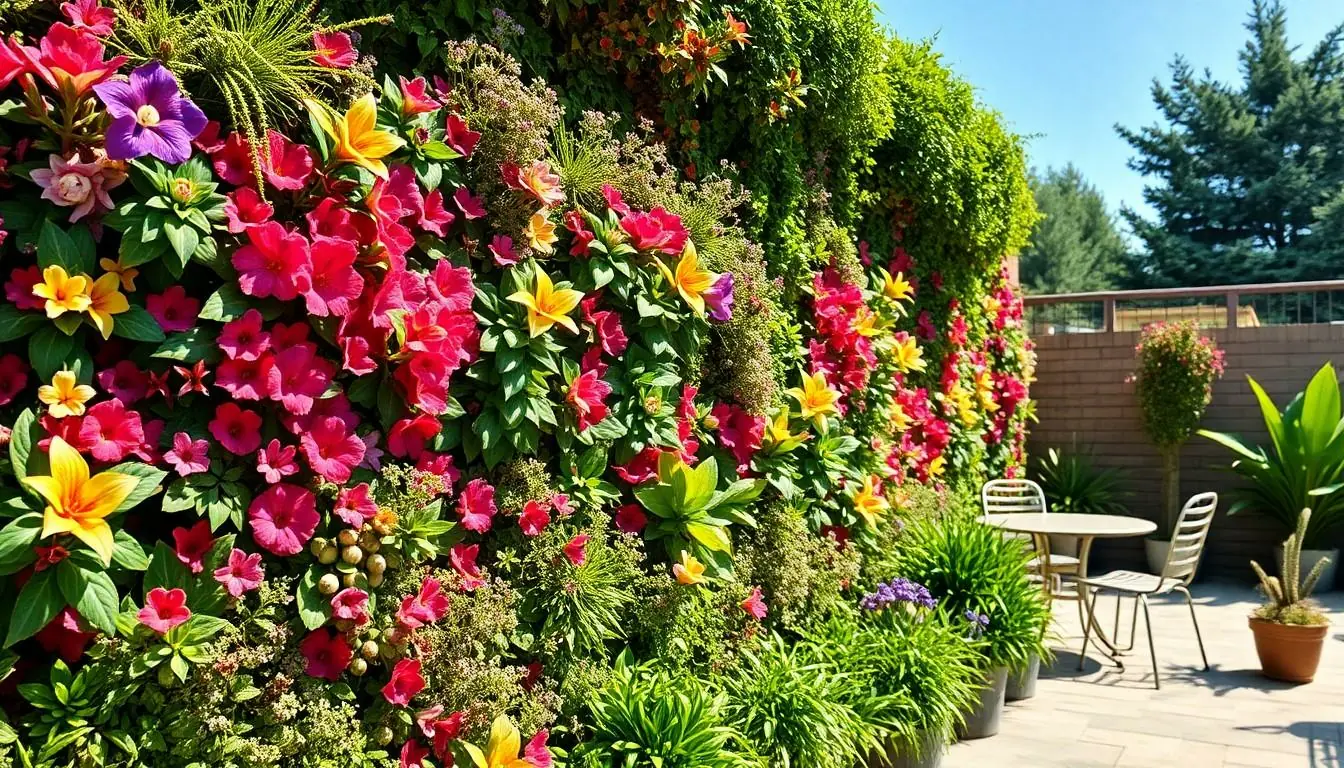Table of Contents
ToggleImagine stepping into your backyard and feeling like you’ve just entered a lush, green paradise. An outdoor living wall can transform any dull space into a vibrant oasis, blending nature with modern design. It’s not just a wall; it’s a vertical garden that brings life, color, and a touch of whimsy to outdoor areas.
With the ability to purify the air and create a stunning visual impact, outdoor living walls are the perfect solution for those looking to enhance their outdoor experience. Whether it’s a cozy nook for morning coffee or a lively dinner party backdrop, these walls are as functional as they are fabulous. So why not ditch the plain old fence and embrace a living masterpiece that even Mother Nature would envy?
Overview Of Outdoor Living Walls
Outdoor living walls, also known as vertical gardens, enhance aesthetics and functionality in outdoor settings. These lush installations consist of various plants arranged vertically, creating a vibrant and inviting atmosphere. They serve not only as decorative elements but also contribute to environmental sustainability by improving air quality and promoting biodiversity.
Benefits of outdoor living walls include effective noise reduction and temperature regulation. Plants absorb sound and provide cooling effects, creating a more comfortable outdoor space. Additionally, these walls can attract pollinators like bees and butterflies, supporting local ecosystems.
Maintenance plays a crucial role in the longevity of outdoor living walls. Regular watering, pruning, and monitoring plant health ensure vibrant growth. Using resilient plant species can minimize the need for excessive care, making them suitable for both novice and experienced gardeners.
Design options vary widely, allowing customization to fit individual preferences and architectural styles. Homeowners can select plants based on color, texture, and seasonal interest to create visually stunning installations. Integrating elements like lighting and irrigation systems enhances functionality while adding an extra layer of appeal.
Installation methods differ as well, ranging from modular systems that can be easily mounted to existing structures to more complex designs requiring professional assistance. Choosing the right approach depends on space, budget, and desired outcomes.
Outdoor living walls transform bland spaces into lush gardens while offering myriad benefits. By incorporating these vertical gardens, homeowners can create inviting outdoor retreats that promote relaxation and connection with nature.
Benefits Of Outdoor Living Walls

Outdoor living walls offer numerous advantages that enhance both the environment and aesthetics of outdoor spaces. Their integration into gardens and patios results in significant benefits.
Environmental Impact
Outdoor living walls contribute positively to the environment. They improve air quality by absorbing pollutants and carbon dioxide while releasing oxygen. Various studies indicate that a single living wall can remove up to 600 pounds of carbon dioxide per year. These vertical gardens also promote biodiversity, providing habitats for birds and beneficial insects. Utilizing native plants in design supports local ecosystems effectively. Moreover, living walls help regulate temperature, cooling surrounding air and reducing energy consumption by minimizing the need for air conditioning. This sustainable approach not only beautifies spaces but also actively participates in combating climate change.
Aesthetic Appeal
Outdoor living walls enhance the visual attractiveness of outdoor areas. Vibrant green plants create a mesmerizing backdrop, transforming bland spaces into lively environments. These walls can feature a diverse range of plants, allowing for endless design possibilities tailored to individual preferences. Various colors, textures, and plant placements offer unique visual experiences season after season. Incorporating living walls encourages creativity in outdoor design, making spaces more inviting for relaxation or gatherings. This captivating aesthetic not only elevates outdoor experiences but also increases property value by adding a unique architectural feature.
Types Of Outdoor Living Walls
Outdoor living walls come in various types, each offering unique features and benefits.
Vertical Gardens
Vertical gardens consist of a collection of plants arranged in a vertical manner, often using specialized structures. Plants such as ferns, succulents, and flowering species thrive in these gardens, providing vibrant colors and texture. They can easily adapt to various outdoor spaces, enhancing their aesthetic value. Besides beauty, vertical gardens offer benefits like air purification and improved thermal insulation. Their design allows for innovative irrigation systems, ensuring plants receive the right moisture levels. Homeowners appreciate the ability to personalize these gardens based on preferred plant types and growth conditions.
Modular Living Walls
Modular living walls utilize pre-planted panels that simplify installation and maintenance. Panels can easily fit together, creating a cohesive look for any space. Various manufacturers offer these systems, making it convenient for homeowners to select compatible styles and colors. Easy scalability allows modular walls to expand or contract according to changing outdoor needs. These systems often come equipped with integrated watering solutions, promoting efficient plant care. They appeal to DIY enthusiasts and professional landscapers alike, as customization options cater to diverse tastes.
Installation And Maintenance
Outdoor living walls require proper installation and ongoing maintenance to thrive. Focus on careful planning and methodical care for optimal results.
Installation Process
Start with selecting the ideal location that offers sufficient sunlight and access to water. Prepare the wall by ensuring it has a sturdy and suitable structure to support the weight of the plants. Consider selecting a modular system or custom design that meets specific preferences. Attach the framework securely, ensuring plants have adequate drainage. Fill the planting pockets with quality soil tailored to the selected plant species. Install an irrigation system for consistent watering that simplifies maintenance efforts. Finally, place chosen plants in their designated locations and enjoy the transformation as they integrate into the space.
Maintenance Tips
Regular maintenance promotes the longevity of an outdoor living wall. Establish a consistent watering schedule to prevent plants from drying out. Prune any overgrown sections to maintain shape and encourage healthy growth. Monitor plant health for signs of pests or diseases, addressing issues promptly to ensure resilience. Fertilize using organic options to nourish plants without harming the environment. Rotate plants seasonally for variety and visual appeal, adapting to changing climates and conditions. Lastly, inspect the irrigation system periodically to ensure it operates effectively, adjusting settings as necessary.
Cost Considerations
Investing in outdoor living walls can vary based on several factors. Initial setup costs generally range from $100 to $300 per square foot, depending on plant selection and system complexity. Maintenance expenses, including watering and pruning, typically add an additional $50 to $100 annually, ensuring plants remain vibrant.
Material choices play a critical role in overall expense. Modular systems, for instance, often feature a lower upfront cost due to simpler installation processes. Conversely, custom-built living walls may entail higher labor costs but provide a unique aesthetic.
Location influences pricing as well. Urban areas may see increased costs due to logistics and space constraints. In contrast, rural installations might benefit from lower labor rates and easier access to materials.
Furthermore, plant selection directly impacts cost. Native plants usually require less maintenance and adapt better to local climates, often making them a cost-effective choice. Exotic plants, while visually appealing, tend to incur higher care and replacement costs.
Installation methods encourage different budgeting approaches. Professional installation ensures expertise but comes with a premium, whereas DIY options can mitigate costs if individuals possess the necessary skills.
Lastly, water and nutrient systems might require additional investment. An integrated irrigation system simplifies care and optimizes growth, leading to reduced long-term maintenance fees. Overall, a clear understanding of these cost elements enables informed decisions when considering outdoor living walls.
Outdoor living walls represent a dynamic fusion of beauty and sustainability. By integrating these vertical gardens into outdoor spaces, individuals can enjoy a vibrant atmosphere while contributing positively to the environment. The aesthetic appeal and practical benefits of living walls make them an attractive alternative to traditional landscaping.
With careful planning and maintenance, these green installations can thrive and enrich outdoor experiences for years to come. Whether enhancing a cozy patio or creating a serene garden retreat, outdoor living walls offer endless possibilities for personalization and enjoyment. Embracing this innovative approach not only elevates outdoor spaces but also supports a healthier planet.



